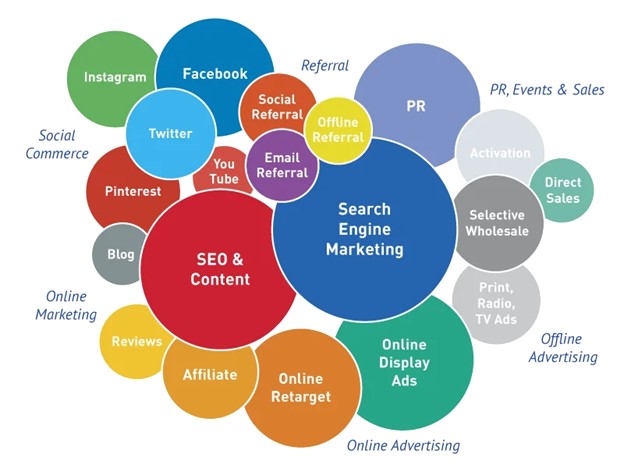Successful alignment between marketing and sales has many benefits. It creates better brand awareness as well as higher quality and quantity in sales. It also leads to an improvement in both growth and profits. However, sales teams in the B2B context often misuse or underuse marketing content. The misalignment of marketing and sales content strategies can cause more than just friction between departments.
Marketing and sales alignment is particularly important if your goal is growth. It also helps better utilize resources over the long term. Ultimately, misaligned goals cost companies huge amounts of money—millions for larger businesses. Avoiding friction and ensuring alignment is critical for any B2B company.

The Basics: What is Sales and Marketing Alignment?
In many companies, the marketing team and the sales team work in silos, often in two separate departments. However, these teams actually have the same goal—driving sales and increasing revenue.
Sales and marketing alignment brings these two pieces of a company together. This alignment involves a unity that focuses on a single revenue cycle. When these pieces work together properly, businesses will dramatically improve marketing return on investment (ROI) and increase sales productivity. Without alignment, the company sees wasted resources, including time and money.
For example, the sales and marketing teams sometimes waste time creating content without any clear goals. Only 43% of B2B businesses surveyed have a “documented” content marketing strategy, yet content marketing generates three times as many leads as traditional marketing in every dollar spent. At the same time, HubSpot (from MarketingSherpa) reports that 79% of marketing leads never convert into sales because of a lack of lead nurturing. In addition, only 56% of B2B organizations verify their leads before they are passed along to sales. Proper alignment between these two vital functions would cut down on both departments’ wasted time, money, and efforts.
The Benefits and Outcomes of Aligning Sales and Marketing Content Strategies
There is an inherent tension between marketing and sales. The sales team has a more direct connection with the target audience, so they can provide valuable insights into comments that real customers or real potential customers have provided. The marketing team develops high-level goals that focus on branding and big-picture growth.
This tension between “big picture” and “boots on the ground” often drives innovation between the two groups. However, when the sales group and the marketing group are not sharing information, that tension becomes a roadblock rather than a benefit.
Cross-functional teams, instead of marketing and sales silos, work much better to promote business growth. When both the sales and marketing teams are on the same page, you will often see the following benefits:
- Shorter sales cycles
- Less wasted resources
- More accurate forecasts
- Increased conversion rates
- Simplified workflows
- Increased efficiencies from shared technology
- Better brand awareness
- Better customer retention
Marketing and sales have the same overall goals, so it makes sense that they should be working toward them together.

Changes in Consumer Behavior in the Digital Landscape
B2B buyers are conducting research online long before they reach out to a sales representative. That means that they need informative, quality content. In fact, B2B buyers spend only about 17% of their time meeting with potential suppliers. That is compared to nearly 30% of their time researching independently online. When they are considering multiple suppliers, that 17% is divided among several sales reps. In fact, B2B buyers often do not contact suppliers directly until the purchase process is nearly 60% complete—and they do not want to connect with sales reps before that time, either.
If there is a gap between marketing and sales, all up-front marketing work goes out of the window. Today’s sales strategies must include a mix of marketing and dedicated sales efforts.
Ways to Align Marketing and Sales Content Strategies
While aligning marketing and sales as a concept may seem simple, it often is not as easy as it sounds. You have to spend considerable time planning and preparing, including getting every team member on board. You can use some of the following methods to align your marketing and sales content strategies.
1. Use customer personas to unite content strategies.
A customer persona is an ideal customer. Developing this persona requires taking a hard look at your target market and creating a very specific description of your ideal customer. These descriptors might fall into several categories, such as:
- Income level
- Family status
- Type of employment
- Age
- Race, nationality, or background
- Education level
You might also have a “current” client rather than an “ideal” client. Knowing the difference between the two is the first step in transitioning toward serving a different type of customer.
Keep in mind a customer may not be the same for every product or service you offer. In fact, various products may interest very different types of people from all walks of life. By creating and sharing these personas with both the marketing and sales team, the two departments are on the same page regarding their target customer.
2. Mapping the customer journey with marketing and sales plans together
Customer journey mapping involves doing a complete walk-through to see what the client sees from the first interest to the final sale. By combining efforts between marketing and sales as part of the customer journey, you will see areas where the two departments are out of touch or where there are gaps that will be a problem for a potential client.
3. Using marketing assets as a sales tool
Marketing assets, including content, can be used directly as a sales tool. For example, content that is too product-centric is not going to result in conversions nearly as often as content that is buyer-centric. Buyer-centric content focuses on the information the buyer wants and needs to move forward in the customer journey.
Even something as simple as giving the sales team the resources to access content quickly and easily can be extremely helpful to get everyone on the same page.
4. Marketing first approaches with your content strategies
Marketing takes up a huge part of the sales and marketing funnel of today. As a result, your approach really needs to address marketing first, and focus on sales second. Marketing targets particular people, and there is a reason for that target—your product or service fills a need.
Ultimately, marketing first means “warming up” the potential client so the sales team can provide whatever necessary additional information and close the deal.
5. The content creation process and sales involvement
Your sales team is the “boots on the ground” for your company. They are often more in tune with customer needs than any other individual or department. As a result, the sales team can be an invaluable resource for content creation. They will know: What questions do customers want addressed? What information do they need before they can purchase? What is the best method to use to convey information? These are the answers you need to plan an effective content strategy.
How to Avoid Unqualified Leads
Unfortunately, the sales team sometimes wastes far too much time on unqualified leads that end up going nowhere. This method often starts from the top, with sales leadership pushing reps to contact ALL leads, no matter where they may fall on the buyer’s journey.
Ultimately, the best way to close sales is to allow the customer the time they need to research and get them the content they need to complete that process. If your leadership is forcing sales to call all leads before they are ready to talk, you risk alienating them, annoying them and potentially losing what could have been a sale.
If your leaders don’t trust the process or are gaming the system to meet their quotas/bonuses, no amount of amazing content will help either team. Marketing to sales is a marathon, not a sprint.









